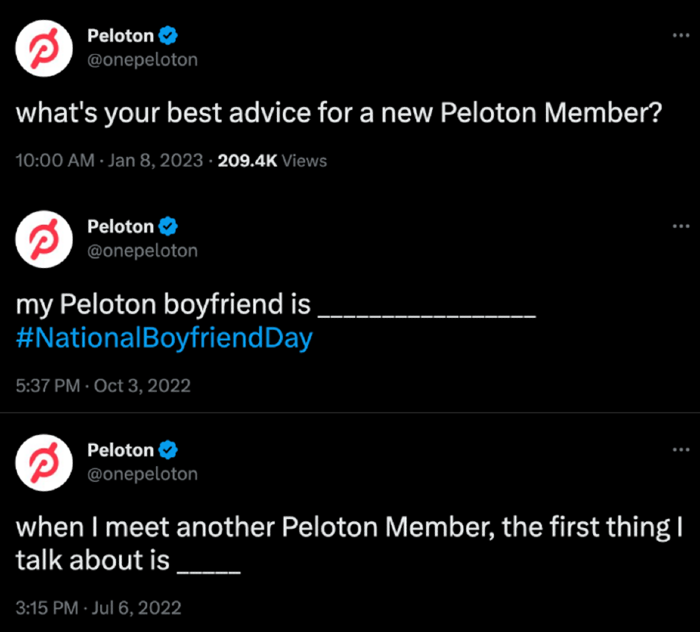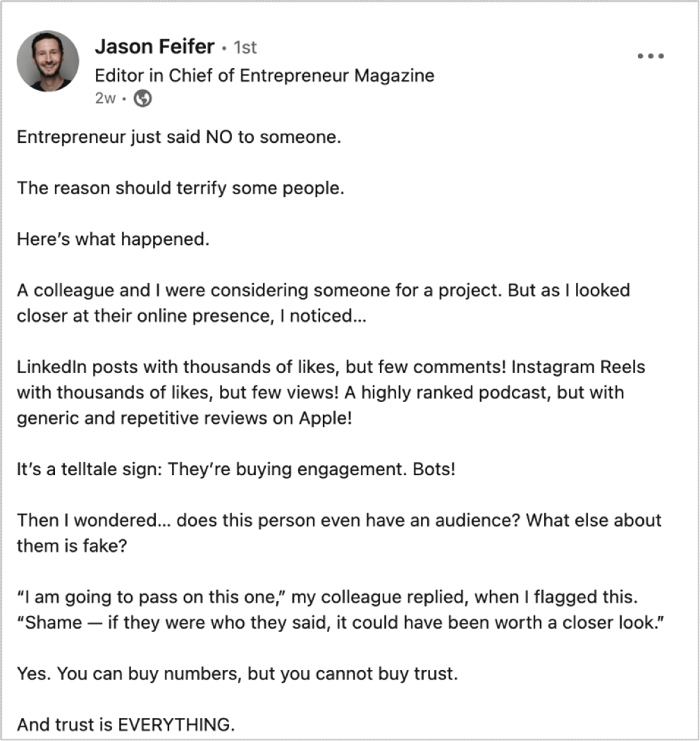My five-year-old told me recently to "drop it in the comments." That should probably make me question her having too much screen time.
Instead, I considered the ubiquity of soliciting comments. Some brands and people do it better than others, but almost everyone does it.
Here are three examples from Peloton that would inspire me to take the comment bait:

(For the record, my answers are, 1. Don't worry about the leaderboard—it's you vs. you, 2. Cody Rigsby, and 3. The favorite instructors we have in common.)
As evidenced by my own compulsion to share my responses, "comment bait" can be effective. But how can you go beyond that "Social Media 101" approach to elevate your commenting strategy?
Two Things You Need to Do for a Strong Comment Strategy
Whether you're considering a comment strategy as a brand or as a person, the execution is similar.
1. Find the right real estate
Just like actual real estate, commenting strategies rely on location, location, location. The value of your comments depends on who is reading them—similar to any other type of content marketing.
In fact, Alice Elliott, the author of How to Create a Commenting Marketing Strategy, compares commenting to a content marketing strategy.
Elliot's ideas might be appealing to overstretched content creators. Writing a series of social media or blog posts takes a great deal of effort. The more time you invest in content creation, the more engagement you need to get an adequate return on investment (ROI). Elliot suggests taking the time you would invest in writing a series of posts and instead using it to comment on the latest relevant and high-ranking content.
Consistent, high-quality comments build brand recognition and drive more visitors to your blog or social profile. "It also helps to establish yourself as a thought leader or go-to-person for particular subjects," adds Elliot.
Side benefits of amping up your comments:
- Keeping on top of the latest trends while researching the best posts to comment on
- Creating a large footprint by spreading your presence and expertise to a broader, but targeted, audience
2. Find the right words
If we learned anything from Cyrano de Bergerac, and I think we did, it's that being in the right place is helpful only if you have the right words to share.
Stefanie Marrone of Social Media Butterfly lays out two crucial rules for LinkedIn commenting etiquette:
- Add value to that post.
- Don't take away the spotlight from the author of the post by promoting yourself or your products/ webinar or directing people to something you did.
How Comments Create (Or Destroy) Trust
The buzz about ChatGPT is inescapable, but don't be fooled by the allure of applying AI in this context. AI is not a shortcut to powering your comment strategy.
Here's an example of how it can backfire.

Entrepreneur rejected someone from consideration for a project because of comments. Not because the person was a troll spreading misinformation or toxic commentary, but because the person had very few comments. A closer look at the candidate revealed LinkedIn posts with thousands of likes but few comments, Instagram Reels with thousands of likes but few views, and a highly ranked podcast but with generic and repetitive reviews on Apple.
"It's a telltale sign: They're buying engagement. Bots!" shared Feifer when telling the story on LinkedIn. "Does this person even have an audience? What else about them is fake?"
The topic of social media metrics can quickly devolve into a heated debate over vanity vs. value metrics, and that can of worms is outside the scope of this discussion. Yet, there is authenticity in comments and authority in both giving and receiving them.
Unlike other social content, comments can't be planned and scheduled for the balance of the year or quarter. Comments require ongoing symmetrical communication.
"You can buy numbers, but you cannot buy trust," said Feifer.
Benefits of Successfully Leveling-Up Your Comments
No one likes people who just talk about themselves all the time. A good conversation is two-way. Commenting emphasizes the "social" in social media.
Using the framework of finding the right place and the right words enables more symmetrical communication. Firing off a parade of posts into a vacuum is easy, but symmetrical communication creates a sense of community. Commenting signals an interest in creating discourse, relationships, and connection.
Comments are reaction and so demonstrate ongoing engagement in a topic or niche. Comments can be perceived as more authentic, but only while staying true to your voice as you would when crafting posts.
The comments that get the most attention are often humorous or witty. Fully 75% of consumers say there's value in brands' exhibiting humor on social media, according to Sprout Social. However, humor does not fit with the tone of every brand or person.
Don't feel pressured to add the funniest comment. Instead, to find the most value, when you "drop it in the comments" write a comment that represents your brand and reinforces your overall content strategy.
More Resources on Social Media Comment Strategy
Don't Run From Online Ratings: Four Tips for the Age of Transparency
How to Turn Negative Social Media Into a Positive
Most Brands Are Not Prepared to Manage Negative Social Comments




